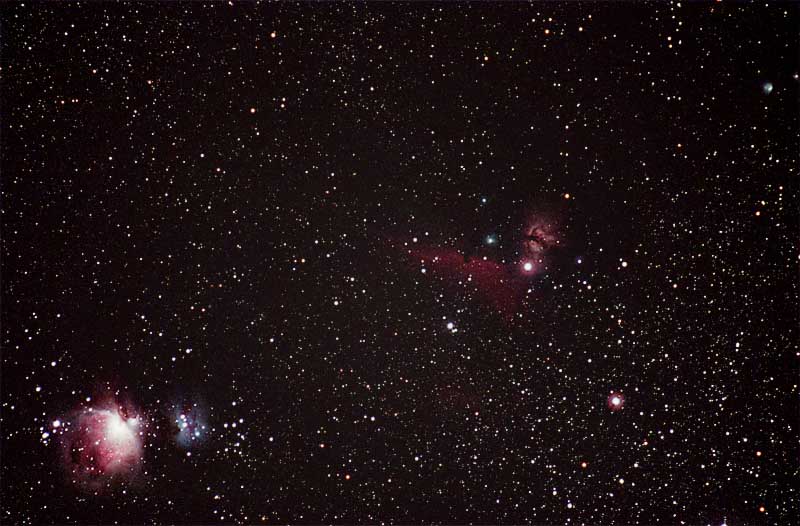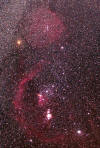

Orion Area, 30 minute exposure, Nikon 300 f2.8 ED lens at f2.8, Kodak LE 400 film.
Objects shown here from left to right: Orion Nebula (M42), NGC 1977 (The Running Man nebula, I believe), the Horsehead Nebula, and the Flame Nebula. The star near the Flame Nebula is the left-most star in Orion's 3 star belt. M42 is in the "sword" part of the constellation. Per SEDS, M43 is actually a part of the Great Orion Nebula, M42, which is separated from the main nebula by an impressive, turbulent dark lane.
This is the full frame. I used a "real" flat fielding technique to get rid of vignetting (see below), which may have cost me a bit of red nebulosity in the middle of the frame. Compared with my Orion Belt at 180mm, you can see that the processing here is much more conservative, which some will like & some won't. Someday I'll go back to this one & get a little more aggressive to bring out more nebulosity.

Orion: Widefield Nebulosity Galore (2007)
Orion Area
Starry Nights Astro Images
Dick's Home Page
Copyright © 2002-2005, by Dick Locke. All Rights Reserved. Contact and Image Use Information
Ron Wodaski posted to following to one of the news groups describing a way to eliminate vignetting. I used this technique above. Jerry Lodrigus has documented another useful technique, but the disadvantage of Jerry's is that you never can get it exactly right throughout the whole frame. The technique below allows you to do that.
I've documented a simple way to created synthetic flat fields using Photoshop in my book "The New CCD Astronomy." It works for both film and CCD images. The basic idea is to use an image that doesn't have extensive nebulosity in it, and to apply Photoshop's Dust and Scratches filter with an appropriate radius that will remove most of the stars in the image. You can use the Clone Stamping tool to clean up any very large stars or small patches of nebulosity that remain. Then apply a strong Gaussian blur (usually in the range of 10-30; depends on what's left) and you will have a very smooth and very accurate pseudo flat-field image. The nifty part of this is that it works well for full-color images. You can apply it in a single step by putting it in a layer above your image, and setting the bland mode to difference. Adjust the blending % to somewhere in the range of 80-95 (usually) to get just the right amount of subtraction. This methods works well for light pollution gradients, too. For more about my book, click on the link in my signature. I've got lots of processing tricks that work for both CCD and digitized film images.